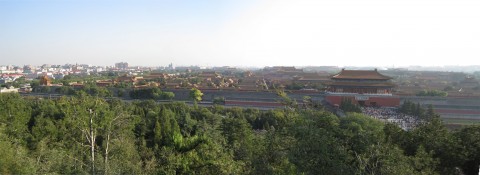Immediately following my visit to the Forbidden City I went to Jingshan Park and ended my day at Beihai Park.

The map of Jingshan Park. The hill was artificially created when the Imperials dug out the lake for Beihai Park. Landscape grading cut and fill!
Admission into city parks in Beijing is fairly standard as I quickly noticed, but the upkeep in these parks is evident. Shanghai, in comparison, does not have such... romantic areas where visual impact is carefully orchestrated.
The closest possibility to it would be the Expo, but even then, the Expo was located on the fringes of Shanghai, where as the Forbidden City takes a central position in Beijing. The view from here was quite impressive to say the least.

The Northwest quadrant of the Fobidden City as seen from Jingshan Park; note that the right hand side is skewed due to quick Photoshop merging
Coming down to sea level (Beijing is famous for being 'pancake flat'), I quickly walked through the rest of the fairly large park. There were quite a few occasions of people singing traditional karaoke, and otherwise reading or enjoying the view. This surprised me because I had not seen such evidence of this in Shanghai, until I visited Zhongshan Park on a Saturday a few weeks later.

I wish this kind of groundcover was more prevalent in urban park design. It softens hard lines such as that wall and hides from view the other walking paths that are really there.

You can't blame the Chinese for at least making the attempt to preserve these unusual lion-seals but it probably does not work.. effectively, and it is also visually jarring. This photograph was taken right outside of a main entrance to the Hall of Imperial Longevity, directly north from the hill of Jingshan Park (shan means mountain in Mandarin).
From this park, I went west and visited Beihai Park before it closed for the day. This would become my second favorite park in Beijing, the first being the New Summer Palace which I will write about right after these photos:

Beihai Park lotus paradise. This is a very impressive plant, it creates such a thick vegetative layer over the water that kayaking among the stands would undoubtly be rewarding.
Now, the namesake for this post has to do with my visit to the New Summer Palace. Yes, there was an Old Summer Palace, it was a very opulent complex built in such eclectic styles that perhaps the world is better off with it remaining a ruin, as it remains today. Sadly, that palace has the idea of a ruin as a theme park and not so much as a real ruin one might find in Old Europe. I was looking forward to that, as ruins are of interest to me as re/generative places for identity and ritual. In any case, I visited the New Summer Palace after seeing the old one, and was I glad I did, because the Old Palace cannot compare to the New even if the former was slightly larger (five times larger than the Forbidden City at 860 acres, 3.5 sq km versus 2.9km for the New).

The 60 meter Longlevity Hill at the Summer Palace. This hill was excavated from the lake below. Or rather, the lake was thus created this way.
The most notable feature of the Summer Palace is the giant lake and similarly massive hill in otherwise flat Beijing. And so, on my way up and over the hill (I entered the park on the far right of the image above), I noticed a sign that read: "Mind the Hilly Road". At the top of hill there was a Buddhist Temple, that, keeping with tradition, did not allow photography indoors, so I leave the exterior facade which was more interesting anyway:
Ah, but the most enjoyable part of the entire park was the walk on the West Corridor of Kunming Lake. It was a very peaceful walk that was relatively free of noisy people and where I could walk my standard 4mph with little effort. The soft effect of the willow trees also immensely added to the atmosphere of the place.











